Where’s the Best Place to Put Your Dishwasher in a New Kitchen?
Use this comprehensive guide to find the most suitable and practical place for your dishwasher
Although every kitchen layout is different, there are reliable guidelines to help you plan where to place everything. And when it comes to appliances, where you put your dishwasher is key. Ideally, it should be located somewhere that makes loading and unloading quick and easy, but it also pays to ensure your dishwasher door doesn’t block any work areas or walkways when it’s open. Here are some handy tips for finding the perfect location for your dishwasher.
Decide on the left or right side
If you intend to position your dishwasher next to your sink, you need to decide whether to put it to the left or right of it. There’s no correct answer, but if you’re right-handed, you’ll tend to hold a plate in your left hand and use your right hand to scrape or wash it, so it’s easier for you to load a dishwasher if it’s to the left of the sink. Similary, the opposite applies to a left-handed person.
If you intend to position your dishwasher next to your sink, you need to decide whether to put it to the left or right of it. There’s no correct answer, but if you’re right-handed, you’ll tend to hold a plate in your left hand and use your right hand to scrape or wash it, so it’s easier for you to load a dishwasher if it’s to the left of the sink. Similary, the opposite applies to a left-handed person.
Having said that, people are often creatures of habit, and I sometimes find my clients prefer to put the dishwasher in their new kitchen on the same side of the sink as in their old kitchen, regardless of whether they’re left- or right-handed.
You also need to consider the overall layout of the rest of the kitchen and the location of other appliances, so try not to become wedded to left or right at the expense of creating a poor layout in other respects.
You also need to consider the overall layout of the rest of the kitchen and the location of other appliances, so try not to become wedded to left or right at the expense of creating a poor layout in other respects.
Note the distance to nearby cupboards
Aim to have a maximum of one step’s distance between your dishwasher to the cupboard that you’re unloading into. Your dishwasher can be adjacent to these units or opposite them – it doesn’t matter as long as you don’t need to move far between them.
Aim to have a maximum of one step’s distance between your dishwasher to the cupboard that you’re unloading into. Your dishwasher can be adjacent to these units or opposite them – it doesn’t matter as long as you don’t need to move far between them.
Ensure the dishwasher is close to drawers
Always position the drawer or cupboard where cutlery or crockery is stored in close proximity to your dishwasher. This kind of functionality and practicality is essential to any good kitchen design. The location of all the appliances in relation to each other, and to the storage in your kitchen, plays an important part in making your cook space a pleasurable place to work in.
Always position the drawer or cupboard where cutlery or crockery is stored in close proximity to your dishwasher. This kind of functionality and practicality is essential to any good kitchen design. The location of all the appliances in relation to each other, and to the storage in your kitchen, plays an important part in making your cook space a pleasurable place to work in.
Check movability within your space
Freedom of movement is an important consideration when designing a room’s layout. This is especially relevant when it comes to the placement of appliances, such as a dishwasher, that open out into the circulation space, and remain open for a period while they’re in use.
When planning your kitchen, visualise yourself carrying out daily tasks such as loading and unloading the dishwasher. Try not to position your dishwasher in a space where it will block off a main walkway when it’s open. It’s also important to consider the location of other appliances, such as a cooker hob, in relation to your dishwasher. Avoid having your dishwasher door open into the area in which someone stands when using the hob or sink.
Having appliance or cabinet doors clash when they open is often unavoidable, particularly in an L- or U-shaped kitchen. However, it’s worth ensuring that your cutlery and crockery drawers can be fully opened at the same time as your dishwasher, to make unloading easier.
Planning your kitchen? These are the 7 key things to remember
Freedom of movement is an important consideration when designing a room’s layout. This is especially relevant when it comes to the placement of appliances, such as a dishwasher, that open out into the circulation space, and remain open for a period while they’re in use.
When planning your kitchen, visualise yourself carrying out daily tasks such as loading and unloading the dishwasher. Try not to position your dishwasher in a space where it will block off a main walkway when it’s open. It’s also important to consider the location of other appliances, such as a cooker hob, in relation to your dishwasher. Avoid having your dishwasher door open into the area in which someone stands when using the hob or sink.
Having appliance or cabinet doors clash when they open is often unavoidable, particularly in an L- or U-shaped kitchen. However, it’s worth ensuring that your cutlery and crockery drawers can be fully opened at the same time as your dishwasher, to make unloading easier.
Planning your kitchen? These are the 7 key things to remember
Install it in an island
If your kitchen has an island, you probably find that this becomes the spot where the dirty dishes are left after they’re first cleared away. For this reason, having a dishwasher in your island is a very good idea. The plates can be quickly cleared away from the island’s worktop, rinsed in the nearby sink if preferred, and then loaded directly into the dishwasher without you having to move to another area of the kitchen.
It may not always be possible to locate a dishwasher in a central island due to plumbing restrictions, particularly if your home is built on a concrete slab. It’s worth checking this with your designer and plumber at the planning stage as it may be prohibitively expensive.
If your kitchen has an island, you probably find that this becomes the spot where the dirty dishes are left after they’re first cleared away. For this reason, having a dishwasher in your island is a very good idea. The plates can be quickly cleared away from the island’s worktop, rinsed in the nearby sink if preferred, and then loaded directly into the dishwasher without you having to move to another area of the kitchen.
It may not always be possible to locate a dishwasher in a central island due to plumbing restrictions, particularly if your home is built on a concrete slab. It’s worth checking this with your designer and plumber at the planning stage as it may be prohibitively expensive.
Integrate your dishwasher
If you have an open-plan kitchen, you may not want your dishwasher to be seen, particularly if it’s visible from your living area. In this instance, consider having an integrated dishwasher, that is, one specially designed to sit behind a panel that matches the rest of your kitchen cabinetry.
There are two main types of integrated dishwashers. One is semi integrated, as shown here, where just the top control panel is visible, with the lower part covered by a cabinetry panel.
If you have an open-plan kitchen, you may not want your dishwasher to be seen, particularly if it’s visible from your living area. In this instance, consider having an integrated dishwasher, that is, one specially designed to sit behind a panel that matches the rest of your kitchen cabinetry.
There are two main types of integrated dishwashers. One is semi integrated, as shown here, where just the top control panel is visible, with the lower part covered by a cabinetry panel.
The other option is a fully integrated dishwasher, as seen here, which is completely hidden, giving the illusion that a cupboard or bank of drawers lies behind the cabinet front. Here, the dishwasher’s controls are located along the top edge of the door, and are only visible when it’s open.
Hide it in a walk-in pantry
Walk-in and butler’s pantries are becoming more popular in kitchens, particularly in new homes. I receive regular requests from clients that their dishwasher and a second sink be located in a butler’s pantry. This way, all the dirty dishes can be taken straight there after a meal, and all the large pots and pans can be washed there, leaving the main kitchen neat and tidy, and the sink empty for rinsing glasses or washing hands.
Busy families and larger households might consider having two dishwashers: one in the kitchen for everyday use, and one in the butler’s pantry for extra dishes or on those occasions when guests come over.
Walk-in and butler’s pantries are becoming more popular in kitchens, particularly in new homes. I receive regular requests from clients that their dishwasher and a second sink be located in a butler’s pantry. This way, all the dirty dishes can be taken straight there after a meal, and all the large pots and pans can be washed there, leaving the main kitchen neat and tidy, and the sink empty for rinsing glasses or washing hands.
Busy families and larger households might consider having two dishwashers: one in the kitchen for everyday use, and one in the butler’s pantry for extra dishes or on those occasions when guests come over.
Elevate it
If you dislike bending down to load and unload your dishwasher, then elevating it may be the solution for you. Building your dishwasher into a taller cabinet – similar to how you would with an eye-level oven – will be easier on your back.
Make use of the extra space below the dishwasher by including a drawer that can be used to store anything from dishwasher tablets to plates or chopping boards. You can finish the height of the cabinet at the top of the dishwasher or continue it to a higher level and include more storage, or even a microwave space, above. Ensure that your dishwasher is installed correctly and fixed into place to avoid any movement.
Where did you put the dishwasher in your kitchen? Share your tips for kitchen design in the Comments below.
If you dislike bending down to load and unload your dishwasher, then elevating it may be the solution for you. Building your dishwasher into a taller cabinet – similar to how you would with an eye-level oven – will be easier on your back.
Make use of the extra space below the dishwasher by including a drawer that can be used to store anything from dishwasher tablets to plates or chopping boards. You can finish the height of the cabinet at the top of the dishwasher or continue it to a higher level and include more storage, or even a microwave space, above. Ensure that your dishwasher is installed correctly and fixed into place to avoid any movement.
Where did you put the dishwasher in your kitchen? Share your tips for kitchen design in the Comments below.




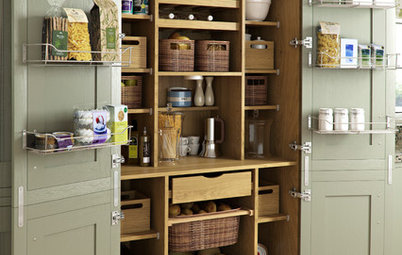
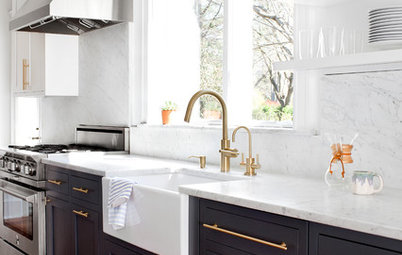
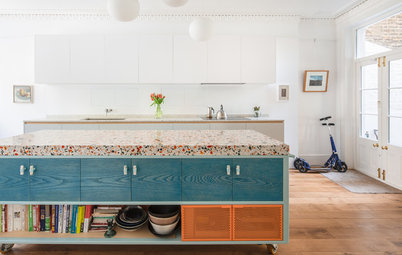
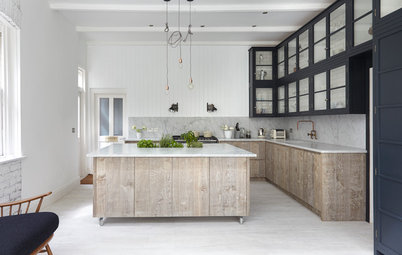

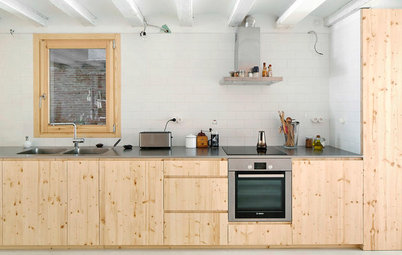
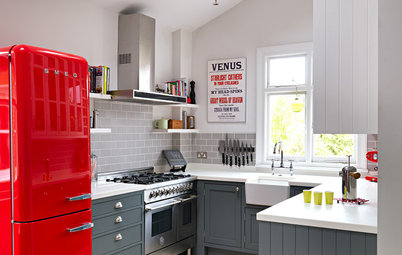
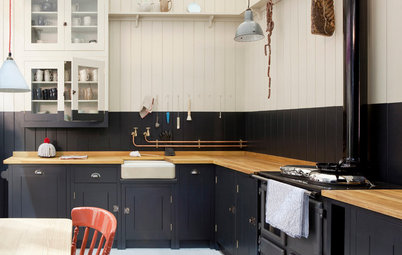
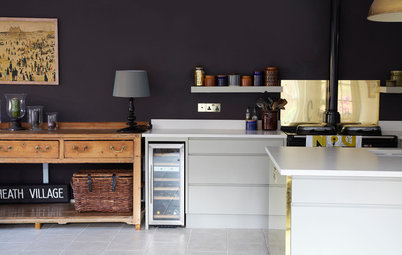
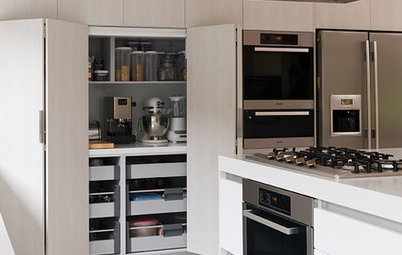
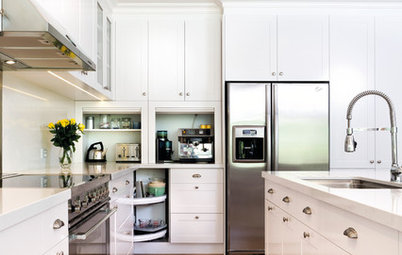
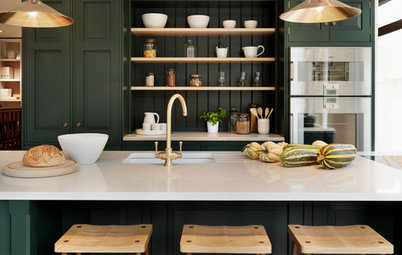
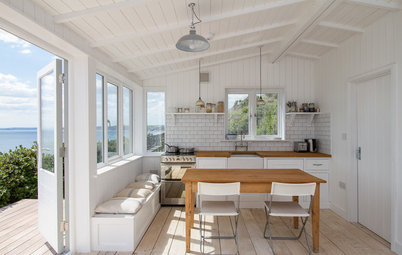
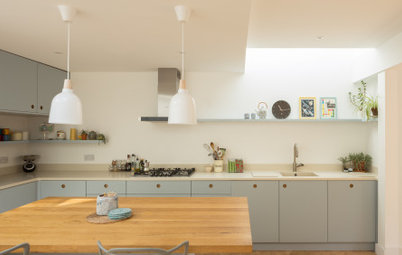

As a kitchen designer, I usually recommend that a dishwasher is positioned next to the sink. There are two reasons for this: firstly, it makes plumbing it in easier and less costly, and secondly, it suits our behaviour. People generally use a ‘scrape, rinse, load’ method to fill their dishwasher. This involves scraping the leftovers from your plates into the bin (located to one side of, or under, your sink), then giving those plates a quick rinse under the tap, before loading them straight into the dishwasher. Consequently, the best place for your dishwasher is on the side of the sink that’s opposite to the scraping area.
There are many dishwashers on the market that don’t require the dishes to be rinsed before they’re loaded. If you buy one of these, then either side of the sink is fine.
Not sure which type of sink to get? Follow this handy guide